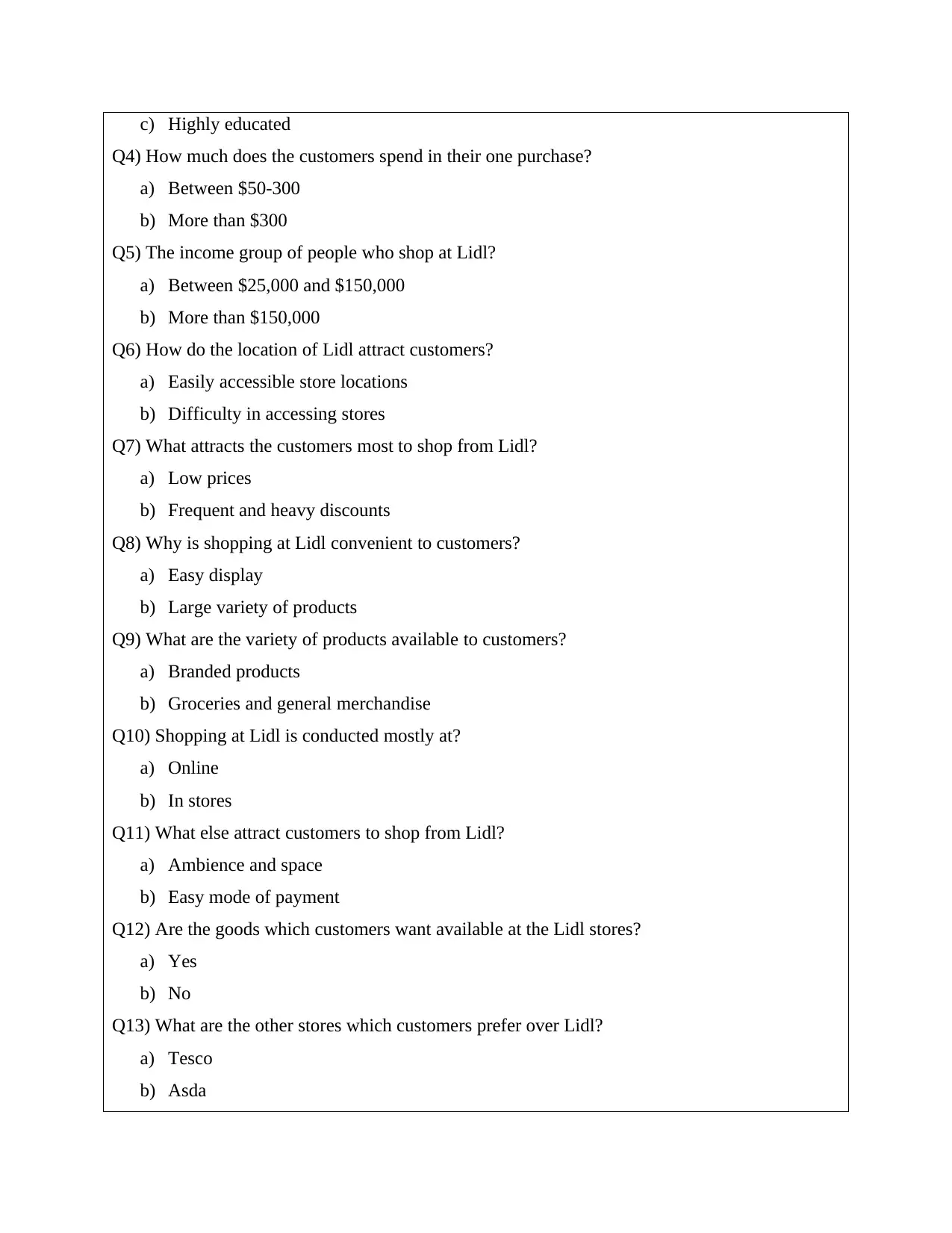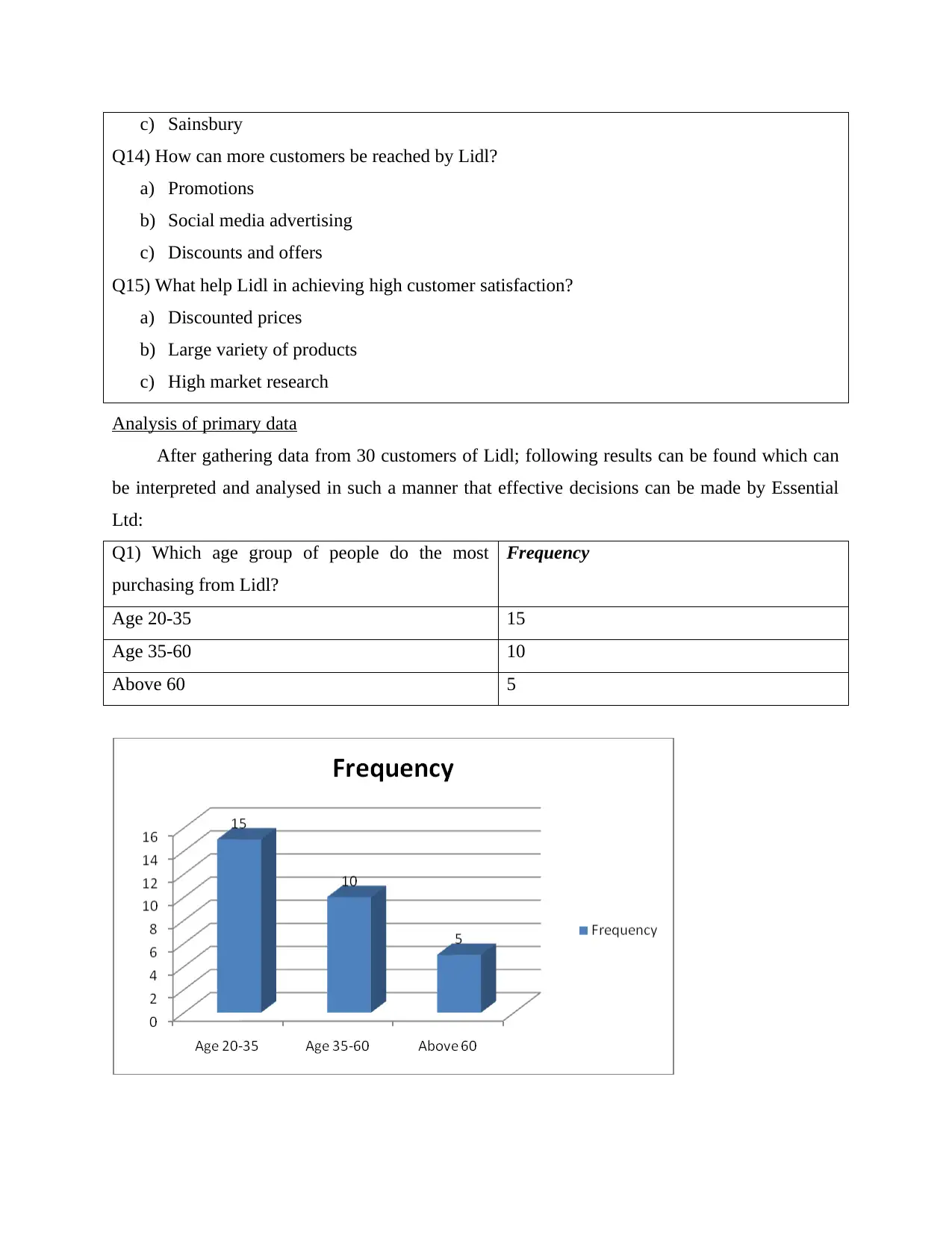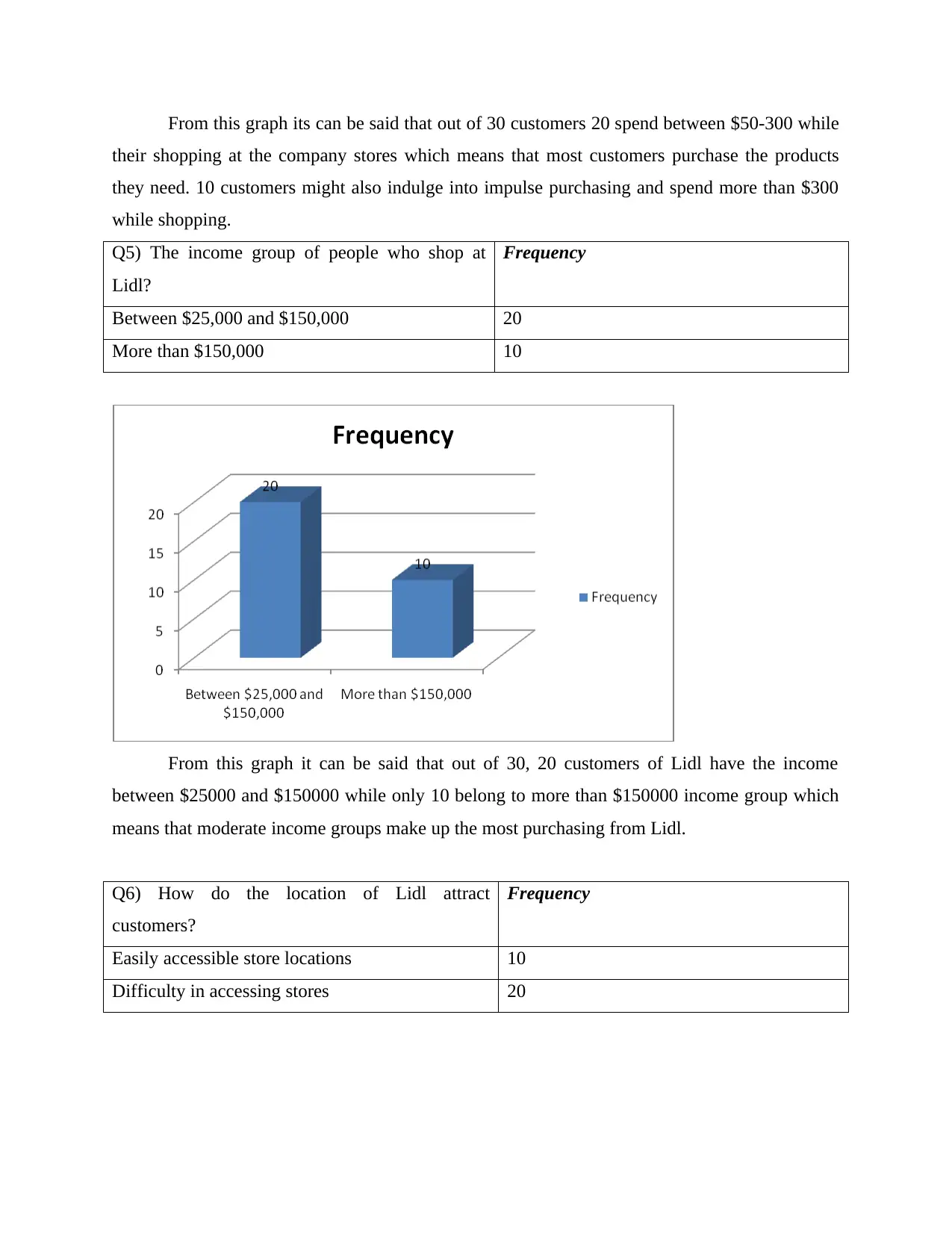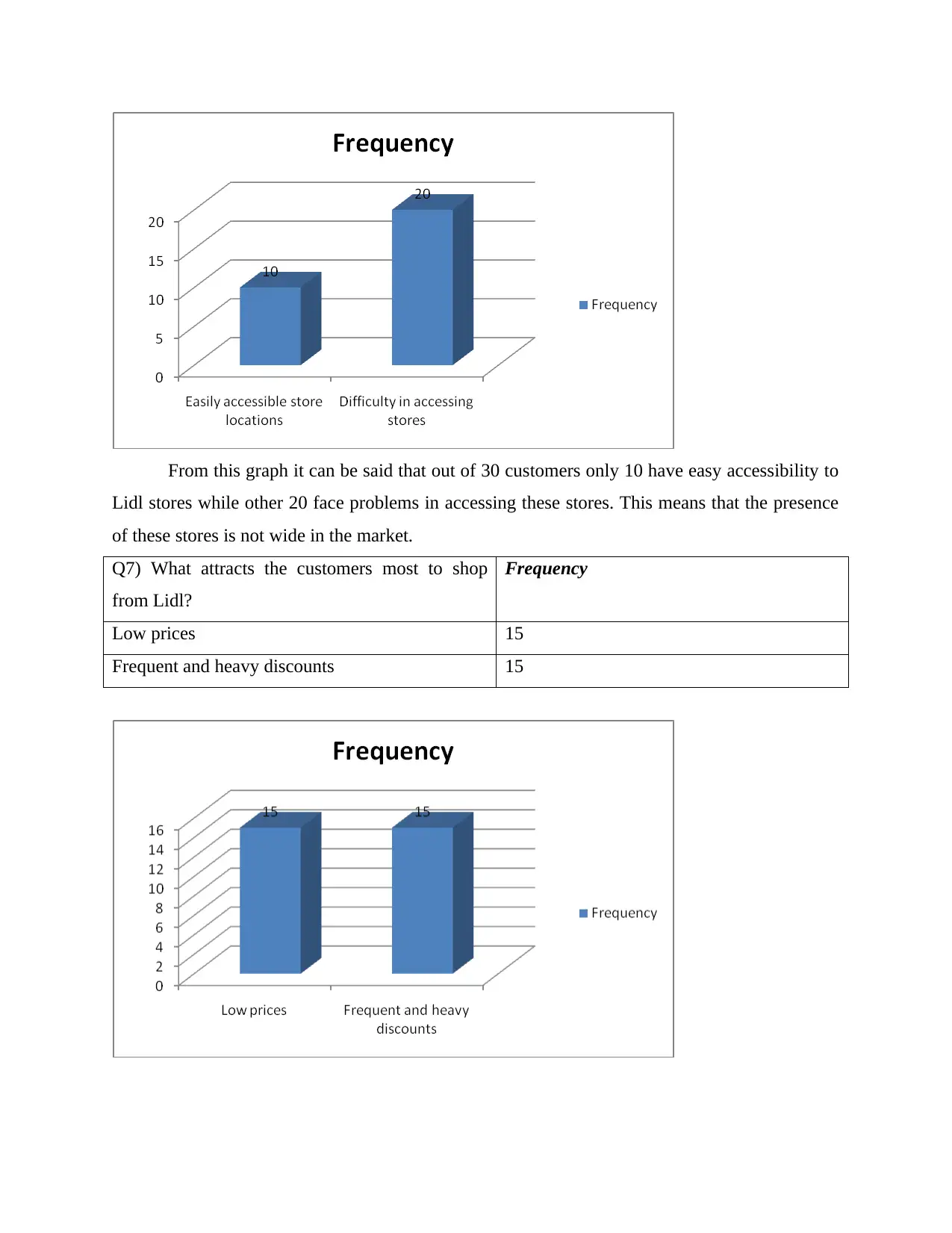Fairfield School BDM Report: Data Analysis for Essential Ltd
VerifiedAdded on 2023/01/12
|21
|3153
|26
Report
AI Summary
This report provides a comprehensive market analysis for Essential Ltd, a company planning to launch supermarket stores in the UK. The report begins with an executive summary and introduction, followed by a detailed exploration of primary and secondary data collection methods. Primary data was gathered through a questionnaire administered to 30 Lidl customers, and the results were analyzed to understand customer demographics, shopping habits, and preferences. Secondary data was collected from various sources to understand Lidl's market position and performance. The analysis includes comparisons with competitors like Tesco, Asda, and Sainsbury's. Key findings highlight customer preferences for low prices, product variety, and convenient store locations. The report concludes with recommendations for Essential Ltd to effectively compete in the UK market, emphasizing the importance of pricing strategies, product offerings, and customer satisfaction. References and appendices support the findings and recommendations.

BDM Report
Paraphrase This Document
Need a fresh take? Get an instant paraphrase of this document with our AI Paraphraser

EXECUTIVE SUMMARY
In order to expand strategically in the market so that the set targets of company can be
achieved it is important that the market is analysed by collecting detailed information through
primary and secondary data collection. These methods help in gaining information regarding the
needs and wants of customers and how the competitors are able to attract customers and fulfil
customer demands. In this report data collection will be done so that before establishing new
business knowledge about the market and competitors can be gained so that efficient business
decisions can be made.
In order to expand strategically in the market so that the set targets of company can be
achieved it is important that the market is analysed by collecting detailed information through
primary and secondary data collection. These methods help in gaining information regarding the
needs and wants of customers and how the competitors are able to attract customers and fulfil
customer demands. In this report data collection will be done so that before establishing new
business knowledge about the market and competitors can be gained so that efficient business
decisions can be made.

Table of Contents
EXECUTIVE SUMMARY.............................................................................................................2
INTRODUCTION...........................................................................................................................4
MAIN BODY...................................................................................................................................4
Primary data collection...........................................................................................................4
Analysis of primary data........................................................................................................6
Secondary data collection.....................................................................................................17
Analysis of secondary data...................................................................................................19
Key findings.........................................................................................................................19
Recommendations................................................................................................................20
CONCLUSION..............................................................................................................................20
REFERENCES..............................................................................................................................21
EXECUTIVE SUMMARY.............................................................................................................2
INTRODUCTION...........................................................................................................................4
MAIN BODY...................................................................................................................................4
Primary data collection...........................................................................................................4
Analysis of primary data........................................................................................................6
Secondary data collection.....................................................................................................17
Analysis of secondary data...................................................................................................19
Key findings.........................................................................................................................19
Recommendations................................................................................................................20
CONCLUSION..............................................................................................................................20
REFERENCES..............................................................................................................................21
⊘ This is a preview!⊘
Do you want full access?
Subscribe today to unlock all pages.

Trusted by 1+ million students worldwide

INTRODUCTION
In the contemporary world where the competition among businesses is increasing, the
importance of data collection and its interpretation so that effective results can be found that can
help in decision making have also become important. In order to efficiently compete in martlet
and to sustain in the competitive market it is important that data is collected using qualitative and
quantitative methods so that an overall view of market can be gained. In this report data
collection and its analysis will be done for Essential Ltd so that it can successfully launch its
supermarket stores that will offer groceries and general merchandise to customers at lowest rates
in UK. Further interpretation of data so collected will be done along with formulation of
recommendations so that it can sustain in the competitive marketplace.
MAIN BODY
Primary data collection
When data is collected for the first time by researcher directly from sources by the way of
questionnaires, surveys, interviews etc. so that fresh data can be gathered that can help in making
correct interpretations and evaluations (Babić, 2017). The authenticity and reliability of such data
collected is high as it is collected directly from the sources by researcher. In order to gain the
responses of customers for the discount supermarket Lidl a questionnaire containing 15 questions
will be used to gather necessary information from 30 customers. This can help Essential Ltd in
gaining information on how Lidl is able to attract a large number of customers.
Questionnaire
Q1) Which age group of people do the most purchasing from Lidl?
a) Age 20-35
b) Age 35-60
c) Above 60
Q2) Which gender group of people shop more at Lidl?
a) Men
b) Women
Q3) What is the educational level of its customers?
a) Less educated
b) Moderately educated
In the contemporary world where the competition among businesses is increasing, the
importance of data collection and its interpretation so that effective results can be found that can
help in decision making have also become important. In order to efficiently compete in martlet
and to sustain in the competitive market it is important that data is collected using qualitative and
quantitative methods so that an overall view of market can be gained. In this report data
collection and its analysis will be done for Essential Ltd so that it can successfully launch its
supermarket stores that will offer groceries and general merchandise to customers at lowest rates
in UK. Further interpretation of data so collected will be done along with formulation of
recommendations so that it can sustain in the competitive marketplace.
MAIN BODY
Primary data collection
When data is collected for the first time by researcher directly from sources by the way of
questionnaires, surveys, interviews etc. so that fresh data can be gathered that can help in making
correct interpretations and evaluations (Babić, 2017). The authenticity and reliability of such data
collected is high as it is collected directly from the sources by researcher. In order to gain the
responses of customers for the discount supermarket Lidl a questionnaire containing 15 questions
will be used to gather necessary information from 30 customers. This can help Essential Ltd in
gaining information on how Lidl is able to attract a large number of customers.
Questionnaire
Q1) Which age group of people do the most purchasing from Lidl?
a) Age 20-35
b) Age 35-60
c) Above 60
Q2) Which gender group of people shop more at Lidl?
a) Men
b) Women
Q3) What is the educational level of its customers?
a) Less educated
b) Moderately educated
Paraphrase This Document
Need a fresh take? Get an instant paraphrase of this document with our AI Paraphraser

c) Highly educated
Q4) How much does the customers spend in their one purchase?
a) Between $50-300
b) More than $300
Q5) The income group of people who shop at Lidl?
a) Between $25,000 and $150,000
b) More than $150,000
Q6) How do the location of Lidl attract customers?
a) Easily accessible store locations
b) Difficulty in accessing stores
Q7) What attracts the customers most to shop from Lidl?
a) Low prices
b) Frequent and heavy discounts
Q8) Why is shopping at Lidl convenient to customers?
a) Easy display
b) Large variety of products
Q9) What are the variety of products available to customers?
a) Branded products
b) Groceries and general merchandise
Q10) Shopping at Lidl is conducted mostly at?
a) Online
b) In stores
Q11) What else attract customers to shop from Lidl?
a) Ambience and space
b) Easy mode of payment
Q12) Are the goods which customers want available at the Lidl stores?
a) Yes
b) No
Q13) What are the other stores which customers prefer over Lidl?
a) Tesco
b) Asda
Q4) How much does the customers spend in their one purchase?
a) Between $50-300
b) More than $300
Q5) The income group of people who shop at Lidl?
a) Between $25,000 and $150,000
b) More than $150,000
Q6) How do the location of Lidl attract customers?
a) Easily accessible store locations
b) Difficulty in accessing stores
Q7) What attracts the customers most to shop from Lidl?
a) Low prices
b) Frequent and heavy discounts
Q8) Why is shopping at Lidl convenient to customers?
a) Easy display
b) Large variety of products
Q9) What are the variety of products available to customers?
a) Branded products
b) Groceries and general merchandise
Q10) Shopping at Lidl is conducted mostly at?
a) Online
b) In stores
Q11) What else attract customers to shop from Lidl?
a) Ambience and space
b) Easy mode of payment
Q12) Are the goods which customers want available at the Lidl stores?
a) Yes
b) No
Q13) What are the other stores which customers prefer over Lidl?
a) Tesco
b) Asda

c) Sainsbury
Q14) How can more customers be reached by Lidl?
a) Promotions
b) Social media advertising
c) Discounts and offers
Q15) What help Lidl in achieving high customer satisfaction?
a) Discounted prices
b) Large variety of products
c) High market research
Analysis of primary data
After gathering data from 30 customers of Lidl; following results can be found which can
be interpreted and analysed in such a manner that effective decisions can be made by Essential
Ltd:
Q1) Which age group of people do the most
purchasing from Lidl?
Frequency
Age 20-35 15
Age 35-60 10
Above 60 5
Q14) How can more customers be reached by Lidl?
a) Promotions
b) Social media advertising
c) Discounts and offers
Q15) What help Lidl in achieving high customer satisfaction?
a) Discounted prices
b) Large variety of products
c) High market research
Analysis of primary data
After gathering data from 30 customers of Lidl; following results can be found which can
be interpreted and analysed in such a manner that effective decisions can be made by Essential
Ltd:
Q1) Which age group of people do the most
purchasing from Lidl?
Frequency
Age 20-35 15
Age 35-60 10
Above 60 5
⊘ This is a preview!⊘
Do you want full access?
Subscribe today to unlock all pages.

Trusted by 1+ million students worldwide

From this data it can be said that most of the customers of Lidl belong to the younger
group of people who buy products in bulk and also are more prone to impulse purchasing which
lead them to purchasing more from the stores. Thus the stores of company keep such items that
attract young customers more like food products which are both healthy and tasty etc.
Q2) Which gender group of people shop more at
Lidl?
Frequency
Men 10
Women 20
It can be said from this graph that mostly women shop from the stores of company as
they come there to collect the daily use groceries and general merchandise. The company tus
maintains a wide variety of stock of such products that can help women in shopping easily so
that they can collect all the items they want for their household.
Q3) What is the educational level of its
customers?
Frequency
Less educated 5
Moderately educated 15
Highly educated 10
group of people who buy products in bulk and also are more prone to impulse purchasing which
lead them to purchasing more from the stores. Thus the stores of company keep such items that
attract young customers more like food products which are both healthy and tasty etc.
Q2) Which gender group of people shop more at
Lidl?
Frequency
Men 10
Women 20
It can be said from this graph that mostly women shop from the stores of company as
they come there to collect the daily use groceries and general merchandise. The company tus
maintains a wide variety of stock of such products that can help women in shopping easily so
that they can collect all the items they want for their household.
Q3) What is the educational level of its
customers?
Frequency
Less educated 5
Moderately educated 15
Highly educated 10
Paraphrase This Document
Need a fresh take? Get an instant paraphrase of this document with our AI Paraphraser

This graph shows that the people making purchases from these stores belong to the
moderately educated group of people who are well aware of the prices of products offered by
company. These people also belong to the moderate income groups who like to purchase high
quality products at low prices.
Q4) How much does the customers spend in their
one purchase?
Frequency
Between $50-300 20
More than $300 10
moderately educated group of people who are well aware of the prices of products offered by
company. These people also belong to the moderate income groups who like to purchase high
quality products at low prices.
Q4) How much does the customers spend in their
one purchase?
Frequency
Between $50-300 20
More than $300 10

From this graph its can be said that out of 30 customers 20 spend between $50-300 while
their shopping at the company stores which means that most customers purchase the products
they need. 10 customers might also indulge into impulse purchasing and spend more than $300
while shopping.
Q5) The income group of people who shop at
Lidl?
Frequency
Between $25,000 and $150,000 20
More than $150,000 10
From this graph it can be said that out of 30, 20 customers of Lidl have the income
between $25000 and $150000 while only 10 belong to more than $150000 income group which
means that moderate income groups make up the most purchasing from Lidl.
Q6) How do the location of Lidl attract
customers?
Frequency
Easily accessible store locations 10
Difficulty in accessing stores 20
their shopping at the company stores which means that most customers purchase the products
they need. 10 customers might also indulge into impulse purchasing and spend more than $300
while shopping.
Q5) The income group of people who shop at
Lidl?
Frequency
Between $25,000 and $150,000 20
More than $150,000 10
From this graph it can be said that out of 30, 20 customers of Lidl have the income
between $25000 and $150000 while only 10 belong to more than $150000 income group which
means that moderate income groups make up the most purchasing from Lidl.
Q6) How do the location of Lidl attract
customers?
Frequency
Easily accessible store locations 10
Difficulty in accessing stores 20
⊘ This is a preview!⊘
Do you want full access?
Subscribe today to unlock all pages.

Trusted by 1+ million students worldwide

From this graph it can be said that out of 30 customers only 10 have easy accessibility to
Lidl stores while other 20 face problems in accessing these stores. This means that the presence
of these stores is not wide in the market.
Q7) What attracts the customers most to shop
from Lidl?
Frequency
Low prices 15
Frequent and heavy discounts 15
Lidl stores while other 20 face problems in accessing these stores. This means that the presence
of these stores is not wide in the market.
Q7) What attracts the customers most to shop
from Lidl?
Frequency
Low prices 15
Frequent and heavy discounts 15
Paraphrase This Document
Need a fresh take? Get an instant paraphrase of this document with our AI Paraphraser

From this graph it is clear that both the low prices offered by company and the frequent
and heavy discounts offered by company on its products help it in attracting a large number of
customers.
Q8) Why is shopping at Lidl convenient to
customers?
Frequency
Easy display 10
Large variety of products 20
This graph depicts that out of the 30 customers 10 are attracted towards Lidl due to the
easy display of products in its stores while the other 20 are attracted due to the presence of large
variety of products in the stores.
Q9) What are the variety of products available to
customers?
Frequency
Branded products 10
Groceries and general merchandise 20
and heavy discounts offered by company on its products help it in attracting a large number of
customers.
Q8) Why is shopping at Lidl convenient to
customers?
Frequency
Easy display 10
Large variety of products 20
This graph depicts that out of the 30 customers 10 are attracted towards Lidl due to the
easy display of products in its stores while the other 20 are attracted due to the presence of large
variety of products in the stores.
Q9) What are the variety of products available to
customers?
Frequency
Branded products 10
Groceries and general merchandise 20

This graph makes it clear that out of the 30 customers 10 shop in the company as it offer
branded products of items and the other 20 are attracted due to the groceries and general
merchandise items which are available in stores.
Q10) Shopping at Lidl is conducted mostly at? Frequency
Online 15
In stores 15
This graph makes it clear that customers of Lidl shop both from its online application and
from the physical stores which makes the customer base of company very large.
branded products of items and the other 20 are attracted due to the groceries and general
merchandise items which are available in stores.
Q10) Shopping at Lidl is conducted mostly at? Frequency
Online 15
In stores 15
This graph makes it clear that customers of Lidl shop both from its online application and
from the physical stores which makes the customer base of company very large.
⊘ This is a preview!⊘
Do you want full access?
Subscribe today to unlock all pages.

Trusted by 1+ million students worldwide
1 out of 21
Related Documents
Your All-in-One AI-Powered Toolkit for Academic Success.
+13062052269
info@desklib.com
Available 24*7 on WhatsApp / Email
![[object Object]](/_next/static/media/star-bottom.7253800d.svg)
Unlock your academic potential
Copyright © 2020–2025 A2Z Services. All Rights Reserved. Developed and managed by ZUCOL.




